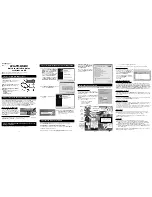
— 34 —
The Dante
Controller
The Dante Controller is a free software utility available from
Audinate, the firm that developed Dante. It is an essential
software means of finding, setting-up and controlling Dante-
enabled devices on your network. It may be downloaded for
operation under either Windows or Macintosh operating sys-
tems from the following link.
https://www.audinate.com/products/software/dante-controller
SNMP OPERATION
Overview
SNMP (Simple Network Management Protocol) allows other
TCP/UDP/IP equipment on the same Local Area Network (LAN)
to communicate directly with your SOFIA 568, and for your unit
to send alarms and supplementary information to other
equipment on the network.
The SOFIA 568 will interface directly with a network controller,
technically known as the SNMP ‘Manager.’ The SOFIA 568 has
an embedded ASCII text file called a Management Information
Base, or MIB. In setting up for SNMP operation, the MIB file will
have to be downloaded from your unit through the Web inter-
face and uploaded to the SNMP Manager. This is detailed later-
on.
Mode
The SNMP submenu default
Mode:
setting is
Disabled
, which in-
hibits communication between the SOFIA 568 and the SNMP
Manager.
Changing
Mode:
to
Read Only
allows the SOFIA 568 to be inter-
rogated by the SNMP Manager, so that programmed setup pa-
rameters, alarms, etc. can be integrated with other equipment
on the network.
Setting the
Mode:
to
Read & Write
allows the SNMP Manager to
send commands to your unit.
Security
SNMP ‘Communities’ serve as passwords for this function. In
the
Read Community:
and
Write Community:
fields, overtype the
factory defaults and enter text that is specified for the
read/write strings on the SNMP Manager monitoring device.
You must do a
Save
after entering your text.
Ports
The default SNMP Ports,
SNMP Port: 161
and
Trap Port: 162
, are
customary for a majority of SNMP operations. Overtype these
defaults to change them.
Trap
Destinations
When the SOFIA 568
initiates
an alarm, rather than being
que-
ried
or
polled
for one, the alarm is known as a ‘trap.’ Three lo-
cal network IP addresses may be entered in the
Trap Destination
1:
,
2:
, and
3:
fields, each corresponding to other devices on the
LAN that need to be apprised of alarms. Overtype the defaults
with valid IP addresses of other equipment.
Summary of Contents for HD Radio SiteStreamer+ SOFIA 568
Page 1: ...SOFIA 568 SiteStreamer Installation User Guide www inovonicsbroadcast com...
Page 2: ......
Page 44: ......









































